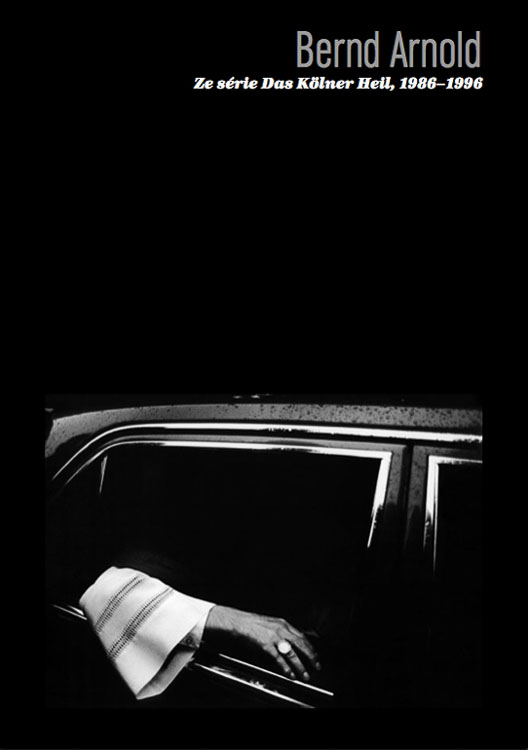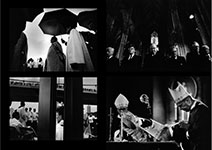
Inscenation in service of ritual?
by Prof. Miroslav Vojtechovsky, Prague
Two photographic exhibitions, both having something to do with matters of staging, were overlapping each other in the capital for roughly a single week only. The Leica Gallery Prague presented against the backdrop of the Prague Castle, close to a place animated annually by a Shakespearean festival, at the end of the last spring an extensive documentary concept of Bernd Arnold symptomatically called "Power and Ritual" whilst the Galerie Rudolfinum was presenting over the whole summer a retrospective exhibition of staged photographs by Ivan Pinkava.
I. Memento at an appropriate place
In connection with Arnold’s exhibition one cannot omit the lecture of the President Václav Havel, delivered in the Hall of Bohuslav Martinu at the musical faculty at the occasion of conferment of an honorary doctorate of AMU. Historically the first holder of the Academy’s honorary doctorate dealt in his speech with his proverbial exactitude not only with some aspects of ‘theatricality’ as an inherent part of politics, but he also pointed out the danger arising from application of dramatic and theatre attributes in politics as a devilishly sophisticated vehicle of perversion.
Who else, but a contemplative dramatist cast by fatal forces into the tentacles of high politics nearly from one day to another one, should realise the positive possibilities and the negative threats in the drama of political staging.
Theatre is for Havel nothing else but "a successor to magic as an attempt to communicate via a ritual speech with hidden forces controlling the world". Drama is then "a specific peculiar attempt to grasp the logic of time and space and thereby of the logic of being itself". Using a quotation from an unidentified source, Havel claimed that if it holds true that "there is ‘everything concentrated’ in politics – law, economics, philosophy and psychology", then politics must per force be also theatre somehow testifying about great events of life and world by means of a system of signs in the framework of a micro-scene.
"But", the sensitive Havel asked "where is the boundary? Where is the limit of legitimate respect towards national peculiarity and history or to symbols of statehood and where is the beginning of the devilish game of pied pipers, black sorcerers and hypnotists of crowds? Where is the end of the admirable art of speaking to the public from the bottom of one’s heart and where is the beginning of God-awful demagogy and of plainly lying tomfoolery?" […]
The milieu of ecclesiastical hierarchy and especially important events of ecclesiastical year on the enclosed stage of the Cologne’s cathedral had been attracting Arnold for a long period of 10 years. The cycle Das Kölner Heil was  doubtless the most refined part of his exhibition display and it turned into a well thought through composition of a homonymous publication. Sophisticated and over centuries elaborated staging processes of ecclesiastical events, stratification and also the unreserved respect for power structures in the ‘institution for salvation’ seemed to Arnold as much removed from the real world as the meetings of contemporary politicians are.
doubtless the most refined part of his exhibition display and it turned into a well thought through composition of a homonymous publication. Sophisticated and over centuries elaborated staging processes of ecclesiastical events, stratification and also the unreserved respect for power structures in the ‘institution for salvation’ seemed to Arnold as much removed from the real world as the meetings of contemporary politicians are.
Backstage views at election campaign of political parties, as much as the unusual glimpses of the gathering of politicians from the most economically developed countries, evolved during a much shorter time period than the pictures from the church environment.
In case of the G-8 Summit, the photographer was, as much as his colleagues, further limited by the specific space designated for cameras of journalists and documentarians. Despite that, his glimpses retained the trenchancy of critical tone of the preceding cycle. The minute scenarios of parts intended for the media, the choreographed poses, a well thought-out gesticulation, innumerably-times repeated handshakes accompanied by optimistic stares into the lenses of cameras, demonstrably exaggerated buoyant gaiety, all that drove the photographer to show to his viewer the averted face of the political theatre that reeks a bit of empty demagogy, if not of the by Havel mentioned lying tomfoolery.
The photographer pointed at the shallowness of political histrionics with certain elegance. There was no trace of threats and demonstration of power, as we know them from the Nazi party assemblies, directed and finally also documented by Leni Riefenstahl. The world has changed and manoeuvring a crowd is now controlled by technologies of pop culture, i.e. its functions are based on a subtle tone of an apparent innocence, but its results are none the less effective. […]
Disk is published by the Research Institute of Dramatic and Scenic Arts at the Theatre Faculty of the Prague Academy of Performing Arts (AMU) headed by Prof. Jaroslav Vostry for the Centre of Fundamental Research of AMU and Masaryk University (MU) in Brno. The activities of the Centre focus on performing arts, and on the side of the Faculty of Arts at MU are carried out by the Institute of Theatre and Interactive Media Studies headed by Prof. Július Gajdos.
"Inscenation in service of ritual?" Review of Power and Ritual in Original Version in Disk 9/2004, p. 83-90, Text © Prof. Miroslav Vojtechovsky